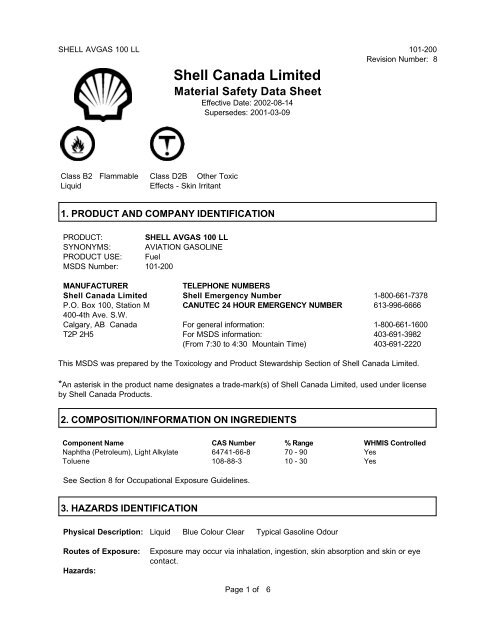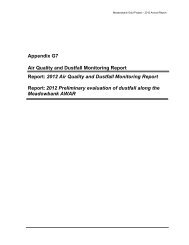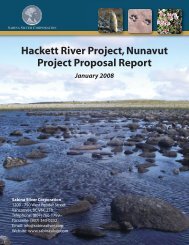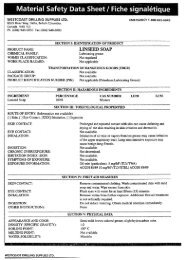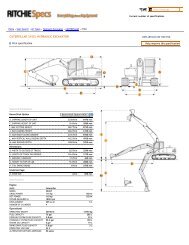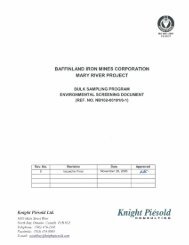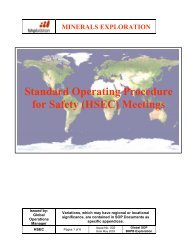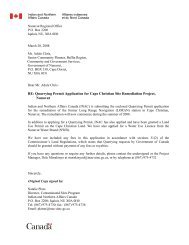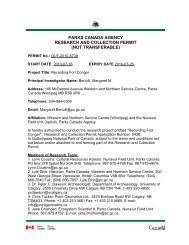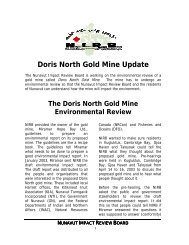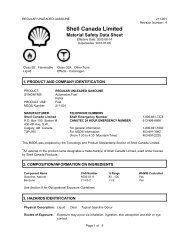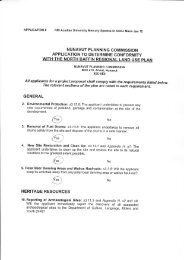SHELL AVGAS 100 LL
SHELL AVGAS 100 LL
SHELL AVGAS 100 LL
Create successful ePaper yourself
Turn your PDF publications into a flip-book with our unique Google optimized e-Paper software.
<strong>SHE<strong>LL</strong></strong> <strong>AVGAS</strong> <strong>100</strong> <strong>LL</strong> 101-200Revision Number: 8Shell Canada LimitedMaterial Safety Data SheetEffective Date: 2002-08-14Supersedes: 2001-03-09Class B2 FlammableLiquidClass D2B Other ToxicEffects - Skin Irritant1. PRODUCT AND COMPANY IDENTIFICATIONPRODUCT: <strong>SHE<strong>LL</strong></strong> <strong>AVGAS</strong> <strong>100</strong> <strong>LL</strong>SYNONYMS: AVIATION GASOLINEPRODUCT USE: FuelMSDS Number: 101-200MANUFACTURER TELEPHONE NUMBERSShell Canada Limited Shell Emergency Number 1-800-661-7378P.O. Box <strong>100</strong>, Station M CANUTEC 24 HOUR EMERGENCY NUMBER 613-996-6666400-4th Ave. S.W.Calgary, AB Canada For general information: 1-800-661-1600T2P 2H5 For MSDS information:(From 7:30 to 4:30 Mountain Time)403-691-3982403-691-2220This MSDS was prepared by the Toxicology and Product Stewardship Section of Shell Canada Limited.*An asterisk in the product name designates a trade-mark(s) of Shell Canada Limited, used under licenseby Shell Canada Products.2. COMPOSITION/INFORMATION ON INGREDIENTSComponent Name CAS Number % Range WHMIS ControlledNaphtha (Petroleum), Light Alkylate 64741-66-8 70 - 90 YesToluene 108-88-3 10 - 30 YesSee Section 8 for Occupational Exposure Guidelines.3. HAZARDS IDENTIFICATIONPhysical Description: Liquid Blue Colour Clear Typical Gasoline OdourRoutes of Exposure:Hazards:Exposure may occur via inhalation, ingestion, skin absorption and skin or eyecontact.Page 1 of 6
<strong>SHE<strong>LL</strong></strong> <strong>AVGAS</strong> <strong>100</strong> <strong>LL</strong> 101-200Revision Number: 8MechanicalVentilation:Use explosion-proof ventilation as required to control vapour concentrations.Concentrations in air should be maintained below lower explosive limit at all times orbelow the recommended threshold limit value if unprotected personnel are involved.Make up air should always be supplied to balance air exhausted (either generally orlocally). For personnel entry into confined spaces (i.e. bulk storage tanks) a properconfined space entry procedure must be followed including ventilation and testing oftank atmosphere.PERSONAL PROTECTIVE EQUIPMENT:Eye Protection: Chemical safety goggles and/or full face shield to protect eyes and face, if productis handled such that it could be splashed into eyes. Provide an eyewash station inthe area.Skin Protection: Impervious gloves (viton, polyvinyl alcohol) should be worn at all times when handlingthis product. In confined spaces or where the risk of skin exposure is much higher,impervious clothing should be worn. Safety showers should be available foremergency use.Respiratory If exposure exceeds occupational exposure limits, use an appropriate NIOSHapprovedrespirator. Use a NIOSH-approved chemical cartridge respirator withProtection:organic vapour cartridges or use a NIOSH-approved supplied-air respirator. For highairborne concentrations, use a NIOSH-approved supplied-air respirator, either selfcontainedor airline breathing apparatus, operated in positive pressure mode.9. PHYSICAL DATAPhysical State:LiquidAppearance:Blue Colour ClearOdour:Typical Gasoline OdourOdour Threshold:Not availableFreezing/Pour Point: Freeze Point = -58 degrees CBoiling Point:75 - 170 degrees CDensity:Not availableVapour Density (Air = 1): Not availableVapour Pressure (absolute): >285 mm Hg @ 38 degrees CpH:Not applicableFlash Point:Method Tag Closed Cup
<strong>SHE<strong>LL</strong></strong> <strong>AVGAS</strong> <strong>100</strong> <strong>LL</strong> 101-200Revision Number: 8Conditions of Reactivity:Avoid excessive heat, open flames and all ignition sources.11. TOXICOLOGICAL INFORMATIONIngredient (or Product if not specified)Naphtha (Petroleum), Light AlkylateTolueneToxicological DataLC50 Inhalation Rat >1<strong>100</strong>0 mg/m3 for 4hoursLD50 Dermal Rat >4000 mg/kgLD50 Oral Rat >8000 mg/kgLD50 Oral Rat = 5000 mg/kgLC50 Inhalation Rat = 8000 ppm for 4 hoursLD50 Dermal Rabbit = 14000 mg/kgRoutes of Exposure:Formulation:Irritancy:Chronic Effects:Pre-existingConditions:Exposure may occur via inhalation, ingestion, skin absorption and skin or eyecontact.This product contains n-hexane.This product is expected to be irritating to skin but is not predicted to be a skinsensitizer.Prolonged and repeated contact with skin can cause defatting and drying of theskin resulting in skin irritation and dermatitis. Prolonged or repeated exposure tohigh vapour concentration or ingestion can cause headache, nausea, dizziness,and central nervous system depression, and in rare cases may sensitize heartmuscles causing heart arrythmia. Peripheral neurotoxicity has been reported inconnection with over exposure to n-hexane. This product contains low levels oflead. Chronic, low grade exposure to lead compounds could lead to insomnia,anorexia, nausea and vomiting, diarrhea, anemia, sensory loss and muscularweakness.Pre-existing eye, skin and respiratory disorders may be aggravated by exposureto this product.12. ECOLOGICAL INFORMATIONEnvironmentalEffects:Biodegradability:Do not allow product or runoff from fire control to enter storm or sanitarysewers, lakes, rivers, streams, or public waterways. Block off drains andditches. Provincial regulations require and federal regulations may require thatenvironmental and/or other agencies be notified of a spill incident. Spill areamust be cleaned and restored to original condition or to the satisfaction ofauthorities. May be harmful to aquatic life. Fish Toxicity: 5 to 40 ppm | 96 hrTLm | Rainbow Trout | FreshwaterNot available. Rapid volatilization.13. DISPOSAL CONSIDERATIONSWaste management priorities (depending on volumes and concentration of waste) are: 1. recycle(reprocess), 2. energy recovery (cement kilns, thermal power generation), 3. incineration, 4. disposal at alicenced waste disposal facility. Do not attempt to combust waste on-site. Incinerate at a licenced wastedisposal site with approval of environmental authority.14. TRANSPORTATION INFORMATIONPage 5 of 6
<strong>SHE<strong>LL</strong></strong> <strong>AVGAS</strong> <strong>100</strong> <strong>LL</strong> 101-200Revision Number: 8Canadian Road and Rail Shipping Classification:UN NumberProper Shipping NameHazard ClassPacking GroupAdditional InformationShipping DescriptionUN1203GASOLINEClass 3 Flammable LiquidsPG IIMarine PollutantGASOLINE Class 3 UN1203 PG IIMarine Pollutant15. REGULATORY INFORMATIONThis product has been classified in accordance with the hazard criteria of the Controlled ProductsRegulations (CPR) and the MSDS contains all the information required by the CPR.WHMIS Class:DSL/NDSL Status:Other Regulatory Status:Class B2 Flammable LiquidClass D2B Other Toxic Effects - Skin IrritantThis product, or all components, are listed on the Domestic SubstancesList, as required under the Canadian Environmental Protection Act.No Canadian federal standards.16. ADDITIONAL INFORMATIONLABEL STATEMENTSHazard Statement :Handling Statement:First Aid Statement :Revisions:Flammable Liquid.Irritating to skin.Eliminate all ignition sources.Wear suitable gloves and eye protection.Bond and ground transfer containers and equipment to avoid static accumulation.Avoid prolonged exposure to vapours.Empty containers are hazardous, may contain flammable / explosive dusts,liquid residue or vapours. Keep away from sparks and open flames.Wash contaminated skin with soap and water.Flush eyes with water.If overcome by vapours remove to fresh air.Do not induce vomiting.Obtain medical attention.This MSDS has been reviewed and updated.Changes have been made to:Section 14Page 6 of 6


